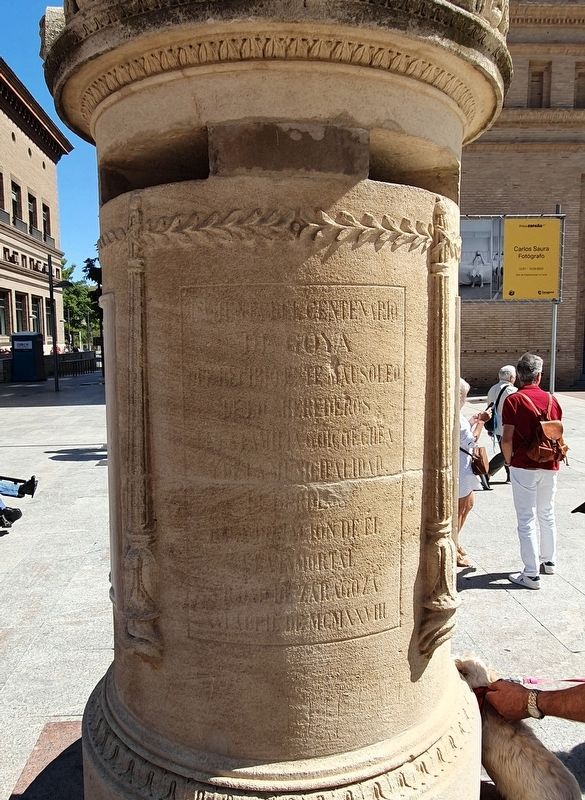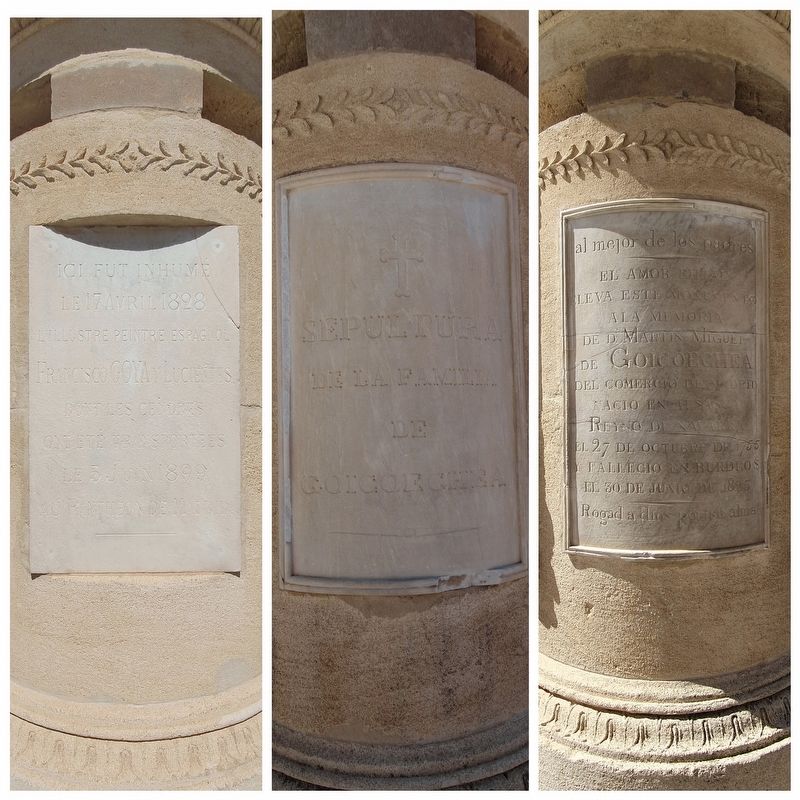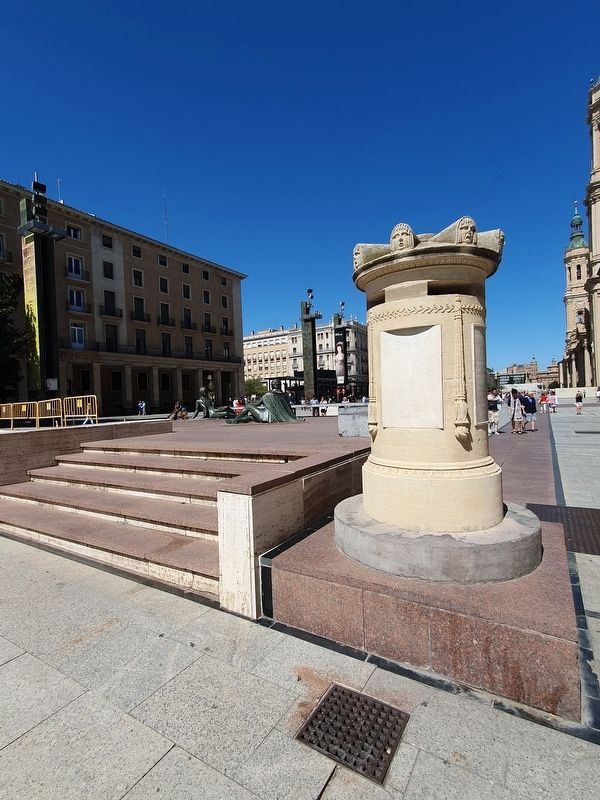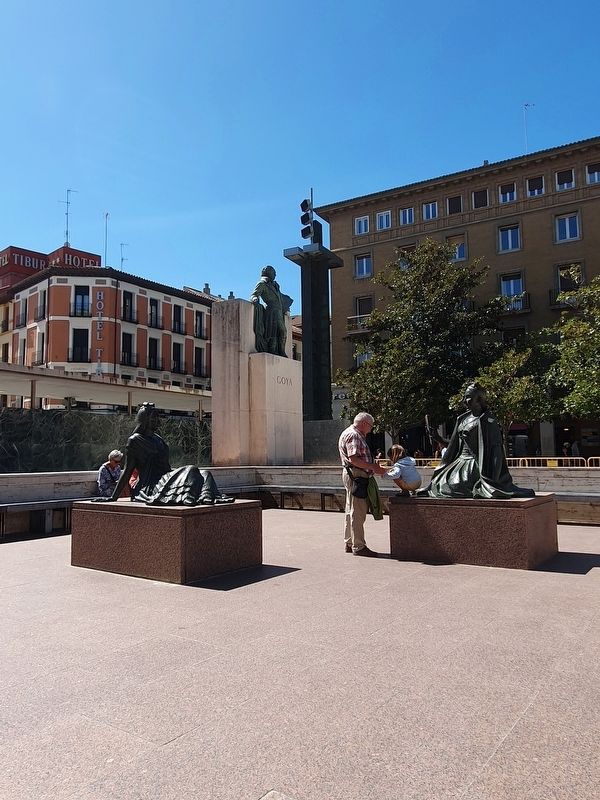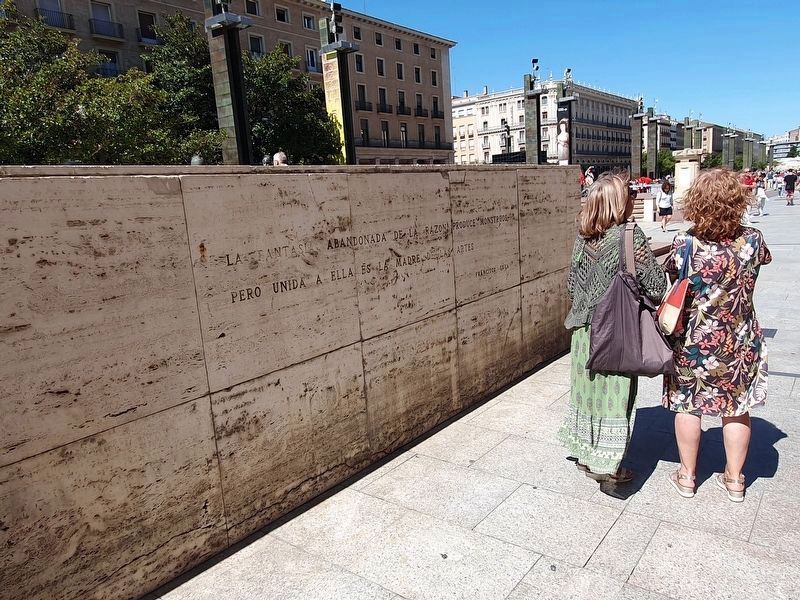Casco Antiguo in Zaragoza, Aragón, Spain — Southwestern Europe (Iberian Peninsula)
Francisco Goya Cenotaph
Al major de los padres el amor filial eleva este monumento a la memoria de D. Martin Miguel Goicoechea del comercio de Madrid
Nacio en Al Sasua, Reyno de Navarra el 27 de octubre de 1755 y falleció en Burdeos el 30 de junio de 1825
Rogad a dios por su alma
The Goya Centenary Board, which received this mausoleum from the heirs of the Goichoechea family and the municipality of Bordeaux, makes a donation of it to the immortal city of Zaragoza. April 1928
To the best of parents. Filial love raises this monument to the memory of Martin Miguel Goicoechea, businessman of Madrid
He was born in Alsasua, Kingdom of Navarre on October 27, 1755 and died in Bordeaux on June 30, 1825
Pray to God for his soul
Topics. This historical marker is listed in these topic lists: Arts, Letters, Music • Cemeteries & Burial Sites. A significant historical month for this entry is April 1928.
Location. 41° 39.34′ N, 0° 52.62′ W. Marker is in Zaragoza, Aragón. It is in Casco Antiguo. Marker is at the intersection of Plaza de Nuestra Señora del Pilar and Plaza de la Seo, on the left when traveling east on Plaza de Nuestra Señora del Pilar. Touch for map. Marker is at or near this postal address: Pl de Ntra Sra del Pilar 16, Zaragoza, Aragón 50003, Spain. Touch for directions.
Other nearby markers. At least 8 other markers are within walking distance of this marker. City Council Victims of 1936 Military Coup (a few steps from this marker); Plaza of the Seo (about 90 meters away, measured in a direct line); La Seo de San Salvador (about 120 meters away); Pope John Paul II in Zaragoza (about 120 meters away); El Pilar Cathedral in the Sieges (about 120 meters away); Plaza de Santa Marta (about 150 meters away); Plaza de San Bruno (about 180 meters away); Santiago Ramón y Cajal (approx. 0.3 kilometers away). Touch for a list and map of all markers in Zaragoza.
Regarding Francisco Goya Cenotaph. This marker includes the inscriptions on the original burial urn of Francisco Goya, which was also part of his wife's family's burial plot. His remains were moved from Bordeaux to Madrid, but there had been plans to have him buried in Zaragoza. As a result, this cenotaph was erected here near the Basilica of El Pilar in Zaragoza.
Also see . . .
1. The Goya Memorial at Zaragoza's Cultural Heritage website (en español). The cenotaph is part of a larger memorial to Goya, one of Spain's best-known painters. (Submitted on October 14, 2023.)
2. Francisco Goya at Wikipedia.
Francisco de Goya was born in Fuendetodos, Aragón, Spain, on 30 March 1746 to José Benito de Goya y Franque and Gracia de Lucientes y Salvador. The family had moved that year to the city of Zaragoza, but there is no record why; likely José was commissioned to work there. They were lower middle-class. José was the son of a notary and of Basque origin, his ancestors being from Zerain, earning his living as a gilder, specializing in religious and decorative craftwork. He oversaw the gilding and most of the ornamentation during the rebuilding of the Basilica of Our Lady of the Pillar (Santa Maria del Pilar), the principal cathedral of Zaragoza. Francisco was their fourth child, following his sister Rita (b. 1737), brother Tomás (b. 1739) (who was to follow in his father's trade) and second sister Jacinta (b. 1743). There were two younger sons, Mariano (b. 1750) and Camilo (b. 1753).(Submitted on October 14, 2023.)
Credits. This page was last revised on October 14, 2023. It was originally submitted on October 14, 2023, by J. Makali Bruton of Accra, Ghana. This page has been viewed 54 times since then and 12 times this year. Photos: 1, 2, 3, 4, 5. submitted on October 14, 2023, by J. Makali Bruton of Accra, Ghana.
